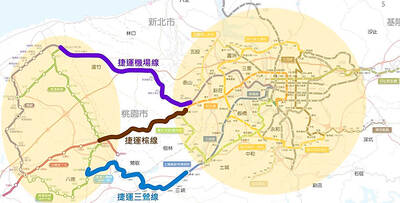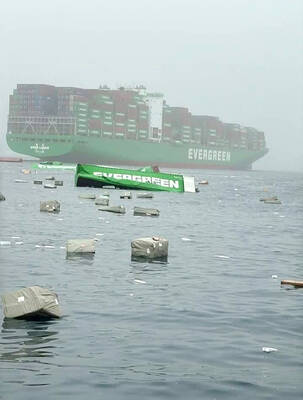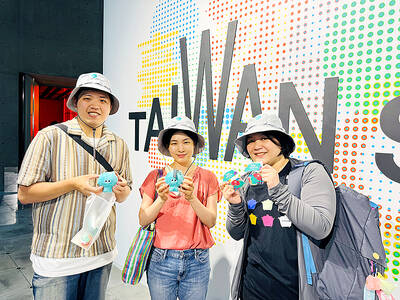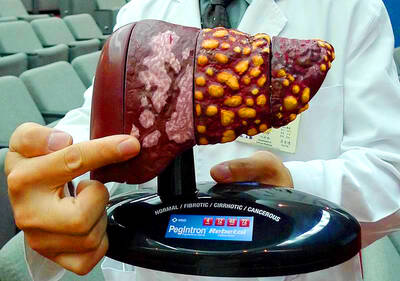The nation’s recycling industry is worth NT$100 billion (US$2.98 billion), the Environmental Protection Administration (EPA) said yesterday, adding that with more research and development, the government hopes to generate even more revenue through recycling.
“Since 2002, countries around the globe have been meeting annually to discuss recycling methods and policies in response to the International Electronics Recycling Congress’ [IERC] establishment of directives on Waste Electrical and Electronics Equipment and Restriction of Hazardous Substances,” director of the EPA’s Recycling Fund Management Board Lin Chien-huei (林建輝) told a press conference.
Because Taiwan’s recycling rates for electronic goods — such as washing machines, computers, television sets, cellphones, and air conditioning units — have been among the highest in the world, the nation has actively participated in such meetings, Lin said.
“While the world’s average recycling rate for these products is 15 percent to 30 percent, Taiwan boasts a 50 percent recycling rate,” he said.
“During this year’s IERC meeting on Jan. 22 in Salzburg, Austria, EPA representatives presented ‘A Review on Taiwan’s National Recycling Scheme for Waste Electrical and Electronic Equipment’ to share our experience of recycling with the world,” he said.
In 1998, the board began a “four in one” recycling scheme that involves the community, the board, recycling companies and government-hired garbage collectors, Lin said.
“The board operates like this: We collect recycling fees from upper-stream manufacturers who are considered responsible for the re-collection of their products at the end of the products’ lifecycles, and in turn use the money to subsidize recycling companies for processing the waste,” he said.
More than half of home appliances are recycled because when a family replaces old appliances with new ones, installers will more likely than not take used machines and take them to recycling stations because the workers are paid to do so, he said.
“This makes the opportunity for recycling large electric appliances very accessible to most households,” Lin said.
As the recycling industry is worth NT$100 billion, Lin called on businesses to invest in new recycling technologies to develop it further.
“With a little investment, we can turn an industry that few countries in the world are interested in into a highly profitable and rapidly growing green industry,” Lin said.
“When the industry matures, we may even be able to attract [recycling] orders from abroad,” Lin said.

The Executive Yuan yesterday approved a southwestern extension of the Sanying MRT Line from New Taipei to Bade District (八德) in Taoyuan, with a goal of starting construction by late 2026. The 4.03-kilometer extension, featuring three new stations, will run from the current terminus at Yingtao Fude Station (LB12) in New Taipei City to Dannan Station (LB14), where it will connect with Taoyuan’s Green Line, New Taipei City Metro Corp said in a statement. This extension will follow the completion of core Sanying Line, a 14.29-kilometer medium-capacity system linking Tucheng (土城), Sansia (三峽)

CARGO LOSS: About 50 containers at the stern of the ‘Ever Lunar’ cargo ship went overboard, prompting the temporary closure of the port and disrupting operations Evergreen Marine Corp, Taiwan’s largest container shipper, yesterday said that all crew members aboard the Ever Lunar (長月) were safe after dozens of containers fell overboard off the coast of Peru the previous day. The incident occurred at 9:40am on Friday as the Ever Lunar was anchored and waiting to enter the Port of Callao when it suddenly experienced severe rolling, Evergreen said in a statement. The rolling, which caused the containers to fall, might have been caused by factors including a tsunami triggered by an earthquake in Russia, poor winter sea conditions in South America or a sudden influx of waves,

The Ministry of Culture yesterday officially launched the “We TAIWAN” cultural program on Osaka’s Nakanoshima sandbank, with the program’s mascot receiving overwhelming popularity. The cultural program, which runs from Aug. 2 to 20, was designed to partner with and capitalize on the 2025 World Expo that is being held in Osaka, Japan, from April 13 to Oct. 13, the ministry said. On the first day of the cultural program, its mascot, a green creature named “a-We,” proved to be extremely popular, as its merch was immediately in high demand. Long lines formed yesterday for the opening

STAY VIGILANT: People should reduce the risk of chronic liver inflammation by avoiding excessive alcohol consumption, smoking and eating pickled foods, the physician said A doctor last week urged people to look for five key warning signs of acute liver failure after popular producer-turned-entertainer Shen Yu-lin (沈玉琳) was reportedly admitted to an intensive care unit for fulminant hepatitis. Fulminant hepatitis is the rapid and massive death of liver cells, impairing the organ’s detoxification, metabolic, protein synthesis and bile production functions, which if left untreated has a mortality rate as high as 80 percent, according to the Web site of Advancing Clinical Treatment of Liver Disease, an international organization focused on liver disease prevention and treatment. People with hepatitis B or C are at higher risk of